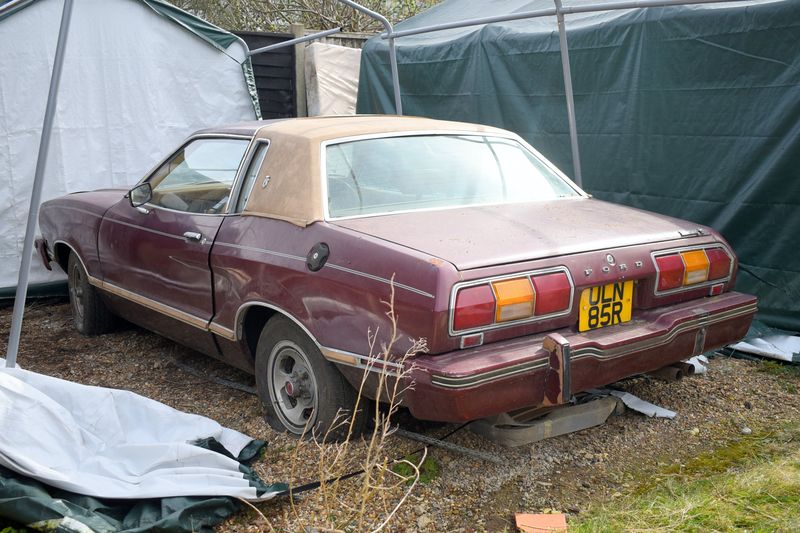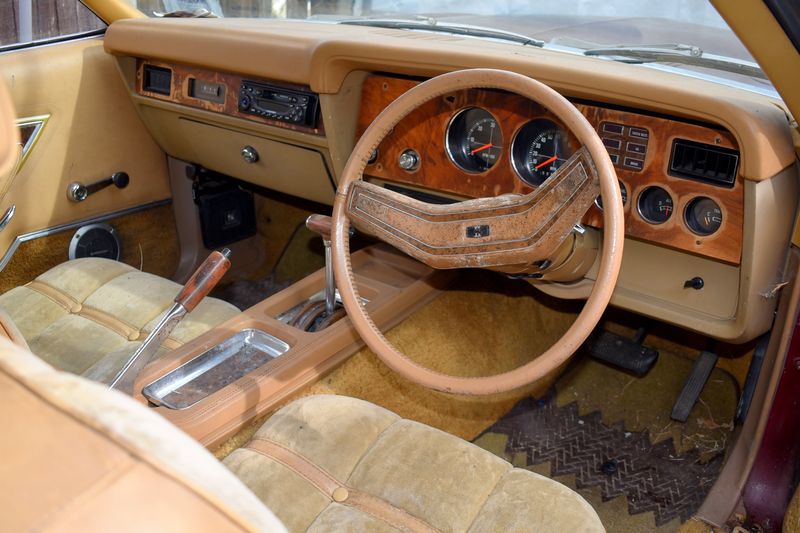NO RESERVE - 1976 Ford Mustang V8 GHIA RHD
Highlights
- One of two extremely rare Mustang IIs discovered in a suburban garden
- Built with right-hand drive for the British market
- Last taxed for the road in 2010
- Sold as a restoration project with huge potential
The Background
It went on to cinematic stardom when Steve McQueen drove a ’68 fastback in the ever-so-stylish film Bullitt, and motorsport enthusiasts were enchanted by the antics of the charismatic Parnelli Jones and others in Trans Am racing.
It’s obvious why the first-generation Mustang is one of the most popular American classics in the world today, but what about the second?
The Mustang II was introduced for the 1974 model year and lasted only until 1978. Available as a coupé or hatchback, with two-plus-two seating, it’s now very obscure.
Why so? Its misfortune stemmed from the fact that it was a child of the fuel crisis and ever-tightening legislation which prioritised safety and emissions over lovely things like powerful engines and dynamic styling.
By any other name, it would be celebrated for what it was – a compact, semi-sporting coupé which was very well received when new because it answered America’s prayers for something smaller and more economical than pre-fuel crisis cars.
It did have some silver-screen kudos of its own, too – the delightful Kate Jackson and Farrah Fawcett both drove Mustang IIs in Charlie’s Angels.
A small 130ci (2.3-litre) straight-four was standard, but a V6 and the well-known 302ci (4.9-litre) V8 were optional. Power output of the latter between 1976 and 1978 was 139 b.h.p. – not bad for a cheap coupé in the regulation-choked ’70s.
Even though 1,107,718 Mustang IIs were built, of which 240,912 were Ghias (1976 Ghia production being 37,515), survivors in Britain are almost mythical.

The History
A Mustang Owners’ Club sticker in the window suggests a period of enthusiast ownership in the past. In 2007, it was purchased by its previous owner, initially with the intention of using it as a spares car for the ’78 Mustang he had bought a year earlier.
However, it turned out to be a much better car than he’d expected, so he kept them both alongside one another.
They have suffered a bit from their exposure to the elements, but both are eminently restorable and should make very rewarding projects for anyone who fancies an unusual American classic.

The Paperwork
Some digital photos will also be supplied showing the Mustang in happier times.

The Interior
The top of the dash is particularly good because it does not appear to have succumbed to the effects of the sun. The wooden dash inserts are showing a few cracks and a general patina, but we think they could be preserved as they are and still look presentable.

The Exterior
As far as we can tell it, seems to be quite structurally sound, although there are some areas of bodywork which will need attention around the sills, door bottoms and lower wings.
Due to water sitting for some time in the offside rear passenger’s foot space, there is a possibility that that section of floor has begun to corrode. Happily, the vinyl landau roof appears to be in very good condition and we don’t think it will require anything besides a good clean.
Indeed, they were an option on the Mustang II and the centre caps indicate that this set is original to the car.

The Mechanics
Since the air filter was removed (though it is still with the car), moisture may well have been present in the carburettor for some time. In order to get the engine running, it is probably going to be necessary to dismantle it to some extent, possibly replacing a number of parts along the way.
While the state of things may not be bad at all, bidders should be prepared for the possibility of the car needing quite a comprehensive mechanical restoration.
You can source almost any mechanical part, even if it has to be imported from the States, and if you do experience any problems then there are numerous American car specialists in this country who could point you in the right direction.

The Appeal
We can appreciate it for what it is – a small, good-looking and relatively economical coupé with no shortage of luxury trimmings.
Even at American car shows, Mustang IIs are hardly ever seen, so when one does show up it draws an interested crowd.
Because it’s compact and right-hand drive it could hardly be better-suited to Britain, and the best thing – it’s got the famous Ford 302 V8, detuned a little but still packing plenty of power.
If we were looking for an American car to restore, we’d be sorely tempted.
Notice to bidders
- Year 1976
- Make Ford
- Model Mustang V8 GHIA
- Colour Maroon
- Odometer 58,401 Miles
- Engine size 4942
- Seller Type Private
- Town Market Harborough
- Location Leicestershire
- Country United Kingdom
- Ja•••• £2,000 07/04/22
- Ja•••• £1,900 06/04/22
- ba•••• £1,800 06/04/22
- Ja•••• £1,700 06/04/22
- ba•••• £1,600 06/04/22
- Ja•••• £1,500 06/04/22
- ba•••• £1,400 06/04/22
- ne•••• £1,300 05/04/22
- ba•••• £1,200 05/04/22
- ba•••• £1,100 05/04/22
The Gallery

About Max Bids
The max bid process allows you to bid without any hassle.
Enter your maximum bid and we will then bid on your behalf to ensure you're the highest bidder - just enough to keep you in the lead and only up until your maximum.
Anti-sniping
Car & Classic prevent auction snipers from bidding in the last seconds to win an auction.
Auctions are extended by 3 minutes if anyone bids within the last 2 minutes to allow other bidders to react and counter-bid.
Auto-bidding increments
- If your maximum bid is equal to or below the reserve price, your maximum bid will be applied in full if you are the highest bidder.
- If you are the highest bidder and place a maximum bid above the reserve, we will automatically put in the reserve as your first bid.
-
- Once the reserve has been met, Car & Classic will make sure you are the highest bidder using only the bidding increments stated below.
- We will keep you in the lead up until your maximum bid OR the increment closest to your maximum bid, providing your maximum bid is enough to cover the increment value.
| Bid Amount | Increment |
|---|---|
| £0 to £9,999 | £100.00 |
| £10,000 to £49,999 | £250.00 |
| £50,000 to £99,999 | £500.00 |
| £100,000 + | £1,000.00 |
Automatically outbid immediately
When you place a max bid and are outbid immediately that means that another bidder has placed a max bid limit which is higher than yours.
You can bid again and we will use our automatic bid system to try and get you as the highest bidder.
Matching max bids
When there are two max bids of the same value, the one placed first remains the lead bidder.
Pre-authorisation
We may hold a pre-authorisation charge on your card until the end of the auction when the hold will be cancelled. If you win, we'll take a security deposit which counts towards the payment for the vehicle and isn't any extra cost to you.
What are pre-bids?
A pre-bid means you're able to place a bid before the official start of the auction.
You will be notified whether or not you are the highest bidder when the auction starts.
Problem with your bid
Bids are contractually binding. To help protect you, we have some rules in place if we think it's been mistyped. Please check and amend what you have entered.




















































































































































































































































































